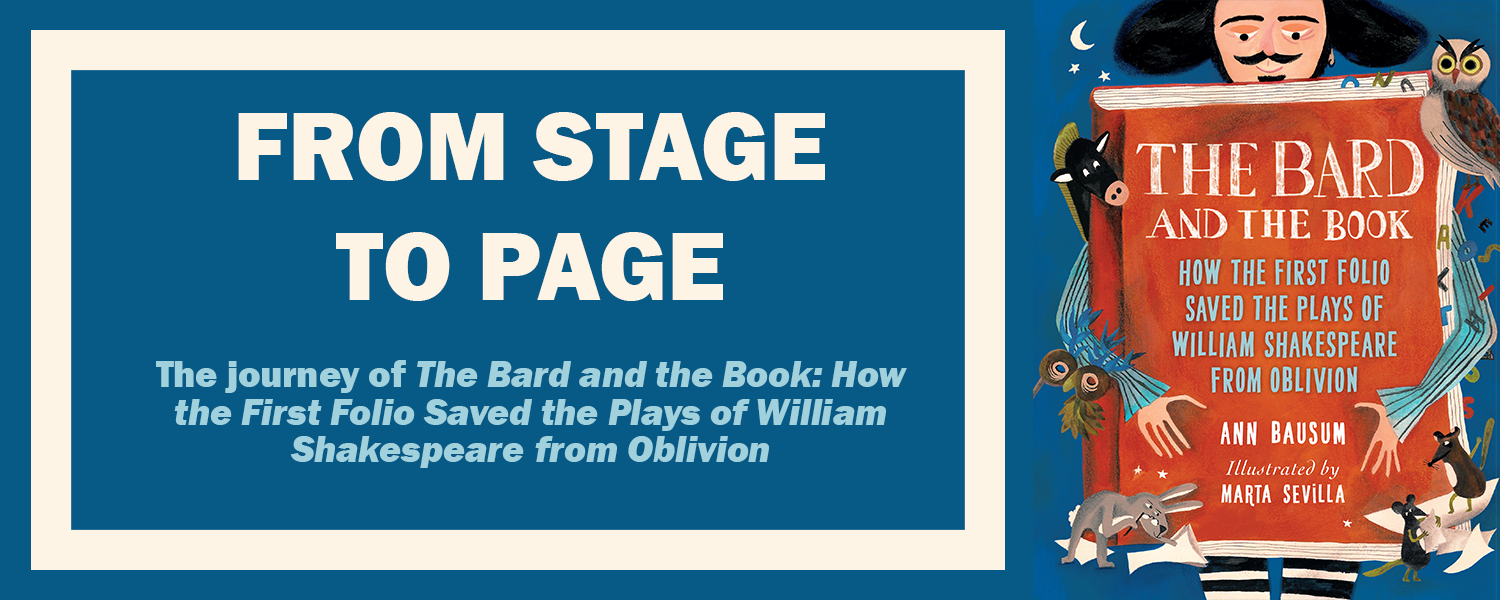Contact Us
American Players Theatre
5950 Golf Course Road
P.O. Box 819
Spring Green, WI 53588
(Map)
Box Office: 608-588-2361
Administration: 608-588-7401
Fax: 608-588-7085
American Players Theatre
5950 Golf Course Road
P.O. Box 819
Spring Green, WI 53588
(Map)
Box Office: 608-588-2361
Administration: 608-588-7401
Fax: 608-588-7085

Author Ann Bausum talks the Bard and her new children's book now on sale in APT's Gift Shops.
Something unexpected happened when I attended a summer performance of The Book of Will in 2019. I didn’t just find wonderful theatre; I found the idea for a new book. During a decades–long career as an author of nonfiction I’ve gotten used to encountering unexpected stories, but I’d never met one on stage before.
If you caught The Book of Will you may understand why I found this production so enchanting. Do you remember its closing scene? As Jim Ridge and Jim DeVita—I mean, John Heminges and Henry Condell—begin to read aloud the plays that they have just collected into the now–famed First Folio, the full cast converges on stage to recite famous lines from the Bard’s collected plays in a chorus of languages. I get goosebumps every time I think about it.

The Book of Will, 2019. Photo by Liz Lauren.
I didn’t have to wait until the end of the show, though, for my own literary inspiration. By intermission I was telling my theatre companion that if the play’s account of the backstory behind the First Folio was true—and it turned out it largely was—then there was a book there for young people. Before the year was out I’d traveled to Washington, D.C., to study at the Folger Shakespeare Library. The Folger houses the largest collection of First Folio copies—82 out of 235 known survivors from the 1623 printing, in fact. To my great good fortune, I was permitted to handle one of them as part of my research.
One pandemic and four–plus years later, meet The Bard and the Book: How the First Folio Saved the Plays of William Shakespeare from Oblivion. This illustrated work of nonfiction is aimed at young people, ages ten and up, but older readers also will make endearing discoveries about the history of the first–ever collection exclusively devoted to dramatic literature.
I’ll offer one case in point which is, well, actually, about cases, specifically the cases that held the individual letters of type that compositors used to set down the words that became each page in the book. These letters were stored in wooden boxes. One case held what were then called majuscule letters—think capital letters. The other held what were called minuscule letters—the non–capital ones. The two cases were stacked, with majuscule letters in the upper one and lower–cased letters in, well, the lower one—which explains why to this day we call these upper– and lower–cased letters. Who knew, right? Well I didn’t!
But with luck, fifth graders and up will begin to learn this detail and more—and fall in love with Shakespeare along the way. May they, too, develop a lifelong pursuit of the Bard, whether climbing the hill at APT or visiting theatres around the globe.

Ann Bausum writes for readers of all ages from her home in southern Wisconsin, making it possible for her to catch every show at American Players Theatre each season, and preferably twice when it comes to Shakespeare, because, well, why not?!
Find more of her work at annbausum.com